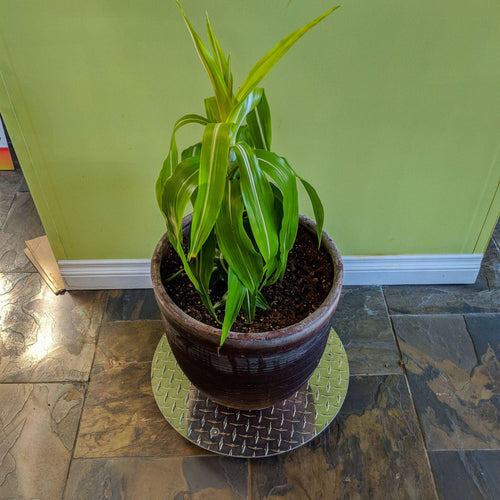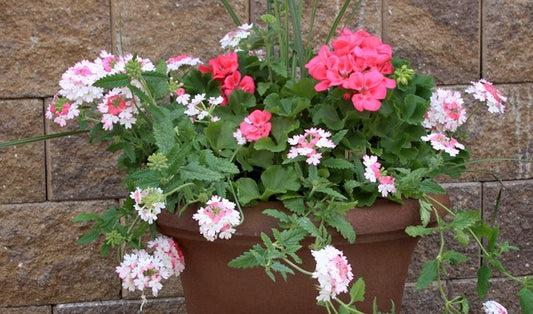The onset of colder temperatures - and perhaps even snow, depending on your location - doesn’t mean all things gardening need to come to an abrupt halt. While you may not be working with plants specifically, there are plenty of creative ways to keep yourself busy with garden-related projects when you’re stuck inside during the winter.
A great use of your downtime during the winter months is to start prepping for the upcoming spring when you can get back outside and begin planting. This isn’t limited to planning your spring garden, thankfully -- there are many other things you can do instead.
Give your potted containers a creative makeover.
Tired of the containers you’ve used season after season? Then pull out your craft supplies, or go shopping for some new ones, to give them a new, updated look.
- Paint them varying shades to compliment your outdoor decor, or to add a pop of color that contrasts what you already have.
- Use mosaic tiles and adhesive to cover the outside of containers to refresh their look.
- Build a stacked planter using multiple planters in different sizes. Many different sets of instructions are available online, with you typically only needing to purchase some shelve brackets, pipe or rod as the main support. Growing plants vertically is a fantastic way to maximize space and add more plants to your outdoor garden.
Over time your potting soil decreases in quality. The original organic matter it contained breaks down to release nutrients for the plants; any supplemental fertilizers are used up; salts may build up with continued fertilizer applications; weed seeds or pests may take up residence in it. To give your container plants a leg up you should periodically refresh it, or replace it entirely.
- If you know the potting mix is free of weed seeds or insect pests, you can simply mix additional slow-release fertilizer and fresh organic material (from your compost bin or purchased from a local retailer) into it. If there are concerns about weed seeds or pests there are numerous ways you can sterilize your previously used potting soil and then add fertilizer and organic matter to it.
- You can also tackle a bigger DIY project and mix new potting soil completely. There are many different “recipes” available online for making your own, with the ability to tailor it to the types of plants you are growing. A basic recipe contains peat moss and compost with additional sand, perlite, or vermiculite.
After refreshing it or mixing new potting soil, keep it in a container inaccessible to pests until it’s time to use it in the spring.
Create a gardening journal.
Even the best memories may forget details from season to season. To help keep track of what you’ve grown, problems you’ve had, successes you’ve seen, things you’d like to do different start a gardening journal dedicated to each individual growing season.
A gardening journal can be a custom bought journal from a bookstore or a simple lined notebook you can stick in your pocket while you are outside working. Use it to note varieties you’ve grown and how they do; sketch out planting diagrams to ensure good crop rotations from season to season; write down when plants are fertilized or treated for pests to ensure proper timing between applications.
Clean and sharpen all your hand tools.
The offseason is the perfect time to take a few hours and make sure all of your gardening tools are clean, sharp, and in good working order. Clean, sharp tools provide nice cuts when pruning and prevent the transmission or introduction of disease from plant to plant.
- Start off by knocking caked-on soil or mud from them, and then give them a quick wash in water using a wire brush to get them clean. Dip them in a diluted bleach solution or wipe them down with isopropyl alcohol as a disinfectant. Wipe wooden handles with a light coat of linseed oil to protect them from drying out and cracking.
- Tools such as shears, loppers, pruners, hoes, and shovels benefit from being sharpened periodically. Wipe the metal blades down with WD-40 or another similar lubricant. Use a 10” flat mill file, following the original bevel on the edge, to create a sharpened 20 to 45-degree angle.
- Hang larger tools on hooks inside a shed or garage to protect them from the outdoor elements. Small hand tools can be stored in a pot that contains sand soaked with motor oil; this helps to keep them sharp and the metal conditioned.
Yes, these ideas or projects might not be as satisfying as being outside with your hands in the soil or admiring your newly blooming flowers, but they are great ways to fill your winter days. Plus, accomplishing these projects in the wintertime means you’re ready to get gardening as soon as the weather allows it!





